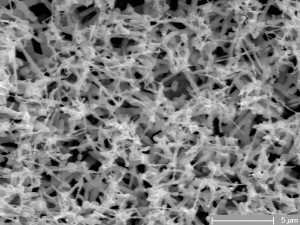 With the scientific world sprinting to build a better battery, researchers at Washing State University in Pullman, announced a breakthrough technology that could triple the capacity of lithium-ion batteries.
With the scientific world sprinting to build a better battery, researchers at Washing State University in Pullman, announced a breakthrough technology that could triple the capacity of lithium-ion batteries.
If the technology can be applied successfully, it could mean possibly tripling electric vehicle range and usage times of battery-powered devices like cell phones and laptop computers.
The researchers, led by Grant Norton, Professor in the School of Mechanical and Materials Engineering, have filed patents on the nanoscale-based technology, which also allows the batteries to re-charge many more times and more quickly than current models. They expect to bring it to the market within a year.
 By using an anode made of tin, rather than the traditional carbon, the new battery has the potential to store almost three times the energy of graphite.? (The anode is the electrode through which the electric current flows.)
By using an anode made of tin, rather than the traditional carbon, the new battery has the potential to store almost three times the energy of graphite.? (The anode is the electrode through which the electric current flows.)
Rechargeable lithium ion batteries are made of two electrodes, the cathode and an anode. During charging, the lithium ions move from the cathode to the anode. The anode holds the lithium ions and stores the battery?s energy. When the battery is used, the ions move from the anode to the cathode, discharging electrons and creating an electric circuit.
Norton and postdoctoral researcher Uttara Sahaym developed the novel material a little over a year ago while working on a project to mitigate tin whiskers, which are literally tiny whiskers that grow on tin-plated electronics. The whiskers, which can sometimes grow as long as 10 millimeters, are a pesky problem in microelectronics because they create short circuits that can cause catastrophic damage. Yet, despite the fact that tin whiskers have been causing problems for more than??60 years, researchers have been unable to come up with ways to entirely avoid them.
Norton and his group decided to turn the problem on its head and see if they could control the growth of tin whiskers, instead of trying to get rid of them. They applied the work to developing a tin-based anode for batteries.
The researchers developed a method for growing tin nanoneedles directly onto copper foil using a standard electroplating process that is commonly used in industry. Electroplating means the tin-based anode costs less than regular graphite anodes with triple the energy storage capacity. The end product battery will look exactly the same as the current batteries, so that manufacturers don?t have to redesign their electronic devices to make room for a new battery.
With support from the WSU College of Engineering and Architecture?s Emerging Technology Fund, which is funded by private donations, the researchers have started building and testing the batteries.








